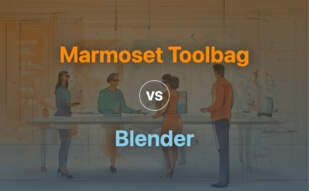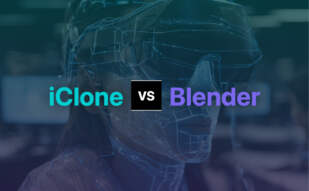
Blender

An expressive liaison between ideas and reality, Blender is a pioneering open-source 3D computer graphics software tool set. Its multitude of feats are harnessed for artistic ventures like animated films, visual effects, interactive 3D applications and augmented reality, among others. Born from the minds at the Dutch animation studio NeoGeo, Blender strode into the public domain on January 2, 1994, and has since grown into a community-fuelled behemoth.
Blender Top Features
- 3D Modelling: Mould shapes into existence and breathe life into scenes in fine detail.
- Animation: Give your creations fluidity and motion to enrapture audiences.
- Video Editing: Make narratives soar to newer heights with streamlined editing tools.
- Rendering: The software’s powerful rendering capabilities allow for a seamless translation from concept to visual spectacle.
- Particle Simulation: Create stunning visual effects from rain to explosions with flexible particle systems.
| Supported OS | Linux, macOS, Windows, BSD, Haiku |
| Developed In | C, C++, Python |
| Available Languages | 36 languages |
Blender Disadvantages
- Minimal real-time rendering compared to contemporaries due to the depreciation of the Blender Game Engine.
- Shift from Blender Internal to Eevee renderer might be disorienting for some users who are acclimated to the older system.
- The vast array of tools can be intimidating for beginners.
Blender Pricing
As a testament to the democratic spirit of the Internet, Blender is completely free and open-source, inviting anyone with a spark of creativity to explore its expansive repertoire.
Blender Use Cases
Use Case 1: Film Production
With its suite of 3D modelling, animation, and video editing tools, Blender serves as an invaluable partner for film production houses that seek to create stunning visual narratives.
Use Case 2: Educational Institutions
Universities and schools alike can harness Blender as a powerful teaching tool, introducing students to the world of 3D graphics and modelling in an accessible, open-source format.
Use Case 3: Indie Game Developers
Where resources are constrained, Blender’s free-to-use, robust tool set provides indie game developers with a means to bring their creative visions to life without hefty overheads.
Unreal Engine
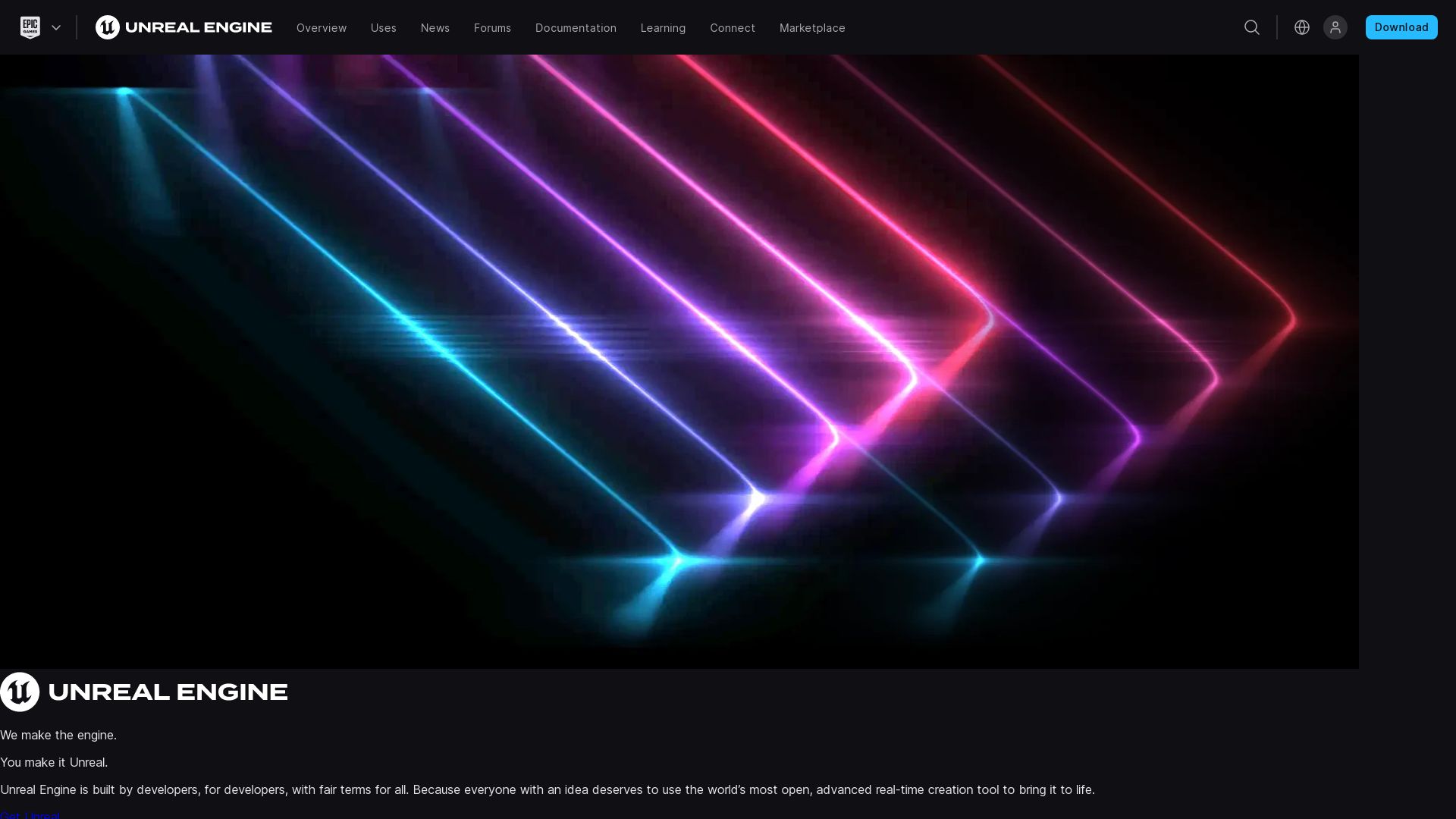
A product of the prominent company, Epic Games, Unreal Engine is a 3D computer graphics and game engine, first brought to public attention in 1998. It has developed exponentially since its inception, broadening its horizons beyond PC first-person shooters, and now serves different game genres, as well as the film and television industry. The engine utilizes C++ as its language and is versatile across a multitude of platforms including desktop, console, mobile, and VR.
Unreal Engine Top Features
- Comprehensive platform support: desktop, mobile, console, VR
- Employs C++ for game development
- Includes UnrealEd, an intelligent level editor supporting real-time constructive solid geometry operations.
- Unreal Development Kit (UDK) for creating iOS games and apps.
- Offers basic project templates for a personalized gaming experience.
- Features from acquired companies like Quixel are incorporated for an enhanced user experience.
| Feature | Benefit |
|---|---|
| Unreal Engine Marketplace | Enables users to buy and sell creations, with an 88% revenue share for content creators. |
| Unreal Engine versions | Constant updates, latest version being Unreal Engine 5, launched in April 2022. |
| Free for academic usage | Offered at no cost to schools and universities for educational purposes. |
Unreal Engine Limitations
- Complicated for beginners due to its use of C++ for game development.
- 5% revenue charge for commercial products over $1 million revenue.
- Modding capabilities primarily applicable to Unreal Engine 3, potentially limiting for new versions.
Unreal Engine Pricing
The engine is free for all users, with a 5% charge on products generating revenue over $3,000 per quarter. However, the royalty model is waived for games published on the Epic Games Store.
Unreal Engine Use Cases
Use case 1 – Game Development
Unreal Engine offers powerful and rich features such as a level editor and C++ for the development of diverse games, making it the go-to for many developers.
Use case 2 – AR/VR Experiences
With extensive support for VR platforms, Unreal Engine can be effectively utilized for creating riveting AR/VR content.
Use case 3 – Film and Television
Unreal Engine’s widening use in the film and television industry testifies to its potential for creating high-quality, lifelike graphics.
jMonkeyEngine
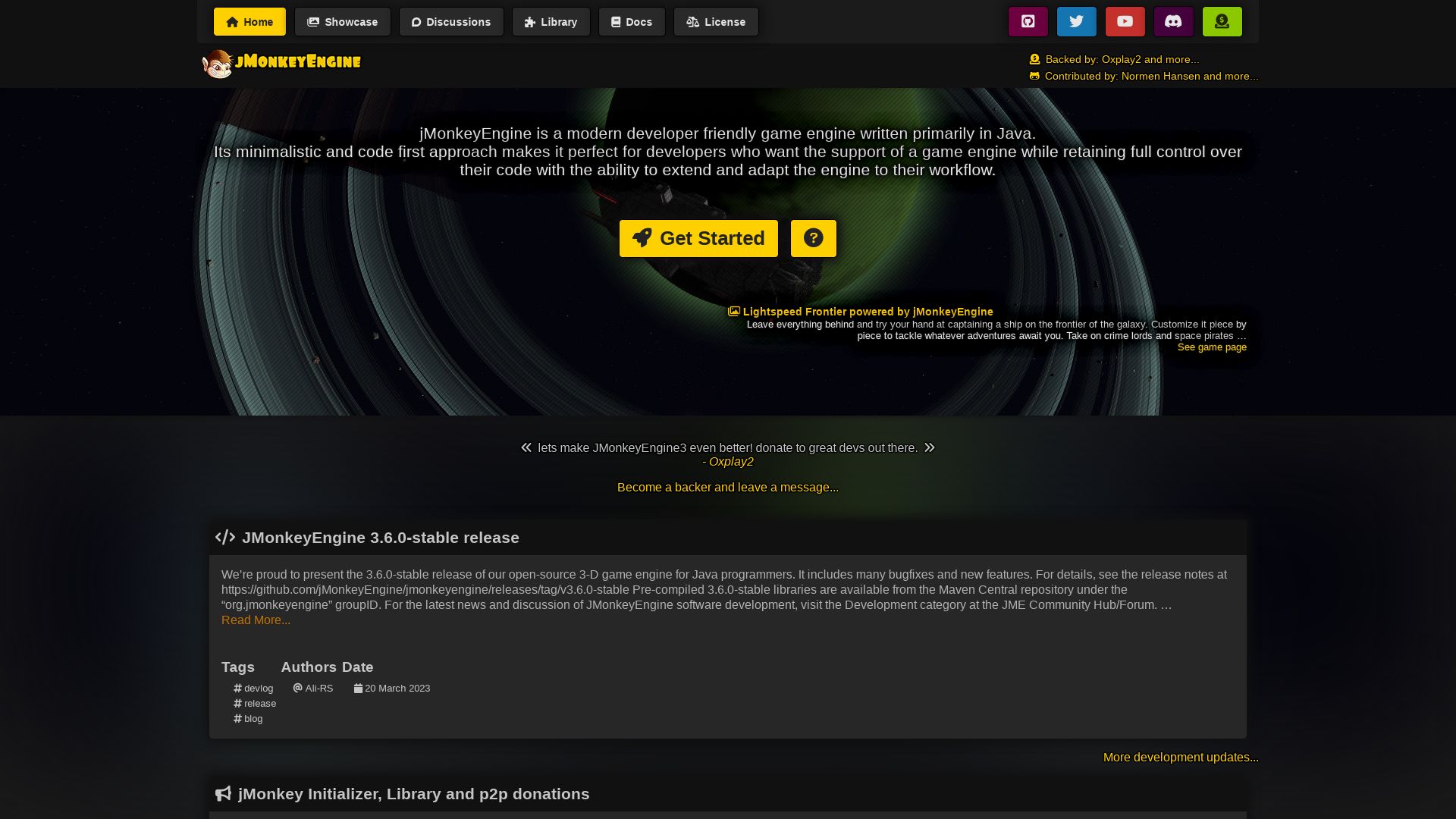
Jumpstart your game development projects with jMonkeyEngine, an open-source, Java-based game engine that sets the bar for coding-first strategies, superb graphics, and cross-platform adaptability. With a recent update that included a robust set of enhancements and bug fixes, jMonkeyEngine keeps your project up-to-date and fine-tuned.
jMonkeyEngine Top Features
- 3.6.0-stable release: Ensures a stable development framework addressing bugs and introducing useful features.
- jMonkeyEngine Initializer: A web tool to get your project off the ground without any hiccups.
- Multiple GUI Options: Choose from Lemur, Nifty GUI, IGUI to match your aesthetic and functionality needs.
- Immersive audio: Utilize 3D audio support with OpenAL and jmePhonon to create a captivating sound environment.
- Advanced Physics Support: Benefit from multiple solutions including jBullet and Minie.
| Paradigms Supported | Spatial-Control model, Zay-ES |
| Community Support | Active developer forum, indepth online documentation, YouTube tutorials and more. |
| Compatible Platforms | PC, Linux, iOS, Android, and Mac |
jMonkeyEngine Limitations
- Higher Learning Curve: Though more adaptable than Unity, this engine still offers a steep initial learning curve.
- Developer Responsibility: Being lower-level, much of the game development process rests in the hands of the developers.
jMonkeyEngine Pricing
jMonkeyEngine is free and open-source, available to the public under a permissive BSD 3-Clause license.
jMonkeyEngine Use Cases
Use case 1 – Serious Game Development
With its code-first approach and stability, jMonkeyEngine is suitable for serious game development projects. Games like Mythruna, currently under development, exemplify its capabilities.
Use case 2 – Game-Education Programs
Use it for game-education programs where learners, both young and adult, can explore game development in a hands-on manner.
Use case 3 – Cross-Platform Game Deployment
Deploy games seamlessly across platforms including PC, Linux, iOS, Android, and Mac, with jMonkeyEngine’s cross-platform compatibility.
Open 3D Engine

In the universe of 3D game development, the Open 3D Engine (O3DE) stands as an impressive star. Developed by the Open 3D Foundation, a subsidiary of the Linux Foundation, this open-source 3D game engine offers a suite of powerful tools for asset building, physics simulation, and animation creation.
Open 3D Engine Top Features
- Modular Structure: O3DE operates on a modular basis, utilizing Gems – unique libraries with standard interfaces and assets. This allows developers to customize their experience extensively.
- Powerful Rendering Capabilities: Atom, the default renderer in O3DE, supports DirectX 12, Vulkan, and Metal graphics API, providing visually stunning results.
- Inbuilt Physics Simulations: O3DE integrates NVIDIA PhysX, NVIDIA Cloth, and AMD TressFX for creating multi-dimensional physics simulations, adding depth and dynamism to your games.
- Access to Multiple Scripting Languages: Script Canvas and Lua are supported in O3DE for crafting compelling runtime logic.
- Workflow Enhancements: The latest O3DE release introduced prefab overrides, script canvas for graph nodes, and automations for content publishing.
- Rendering System Improvements: The recent update also includes improvements in memory support, mesh instancing, mobile shader performance, multi-GPU support framework, and raytracing reflections.
| Key Collaboration | Key Outcome |
|---|---|
| Project Eureka | Partnership with Rochester Institute of Technology aims to foster O3DE adoption among next generation developers. |
| Improved Export Ability | It’s now easier to export projects across Windows, Linux, Linux Server, iOS platforms. |
| Impressive Partnerships | Support from major players in the tech world – Adobe, AWS, Epic Games, and Microsoft to name a few. |
Open 3D Engine Disadvantages
- Given that O3DE is a new entity, the community support may not be as robust as other established engines.
- O3DE’s documentation can be improved to provide better guidance for developers.
Open 3D Engine Pricing
Aesthetics, logics, and dynamics, all wrapped up in one package, and the most enticing part – it’s free! Open 3D Engine is a free and open source platform, enabling anyone to dive into the world of game development.
Open 3D Engine Use Cases
Use case 1 – Game Development Studios
With its robust suite of tools and modular structure, O3DE is an ideal choice for game development studios to create visually breathtaking and highly interactive games.
Use case 2 – Educational Institutions
Through its collaboration with academic institutions, O3DE can serve as an effective tool for teaching game development and fostering the next generation of game developers.
Use case 3 – Independent Developers
For independent developers, O3DE’s no-cost barrier and community-centric ethos provide an accessible platform to experiment, innovate, and bring their ideas to life.
libGDX
Blow up the world of game development with libGDX, a Java-based framework wielding over a decade of trailblazing existence & unrivaled with its robust, code-centric methodology.
libGDX Top|Best Features
- Boasts a unified API for cross-platform targeting: Windows, Linux, macOS, Android, iOS, and Web.
- Rendering prowess secured by OpenGL ES 2.0/3.0.
- Wear your developer-armor with pride, courtesy of fine-grained control.
- A sterling third-party ecosystem with a robust foundation underpinned by extensive documentation.
| Feature | Description |
|---|---|
| Audio Streaming | Support for WAV, MP3, OGG format along with Direct PCM sample playback and recording. |
| 2D & 3D Physics | Via Box2D physics & Bullet physics respectively. |
| Game Services Integration | Easy assimilation with Google Play Games, Apple Game Center and supports in-app purchases. |
libGDX Limitations
Grit your teeth, there aren’t any, at least none that we can list. It’s open source. But hey, nothing’s perfect, right?
libGDX Pricing
Throw your worries to the wind: libGDX is free to use. Yes, you read it right — jump into the fray and create to your heart’s content, without shelling out a single penny.
libGDX Use Cases
Use case 1
libGDX proves its mettle for those seeking control with a code-centric approach to game development. Its unified API facilitates comprehensive cross-platform targeting.
Use case 2
For the audio enthusiasts out there, flex with libGDX’s audio streaming prowess. Direct PCM sample playback and recording have never felt this appealing.
Use case 3
If your ambition scales the heights of 3D physics, libGDX is your knight in shinning armor, serving solid with its Bullet physics.
Love2D
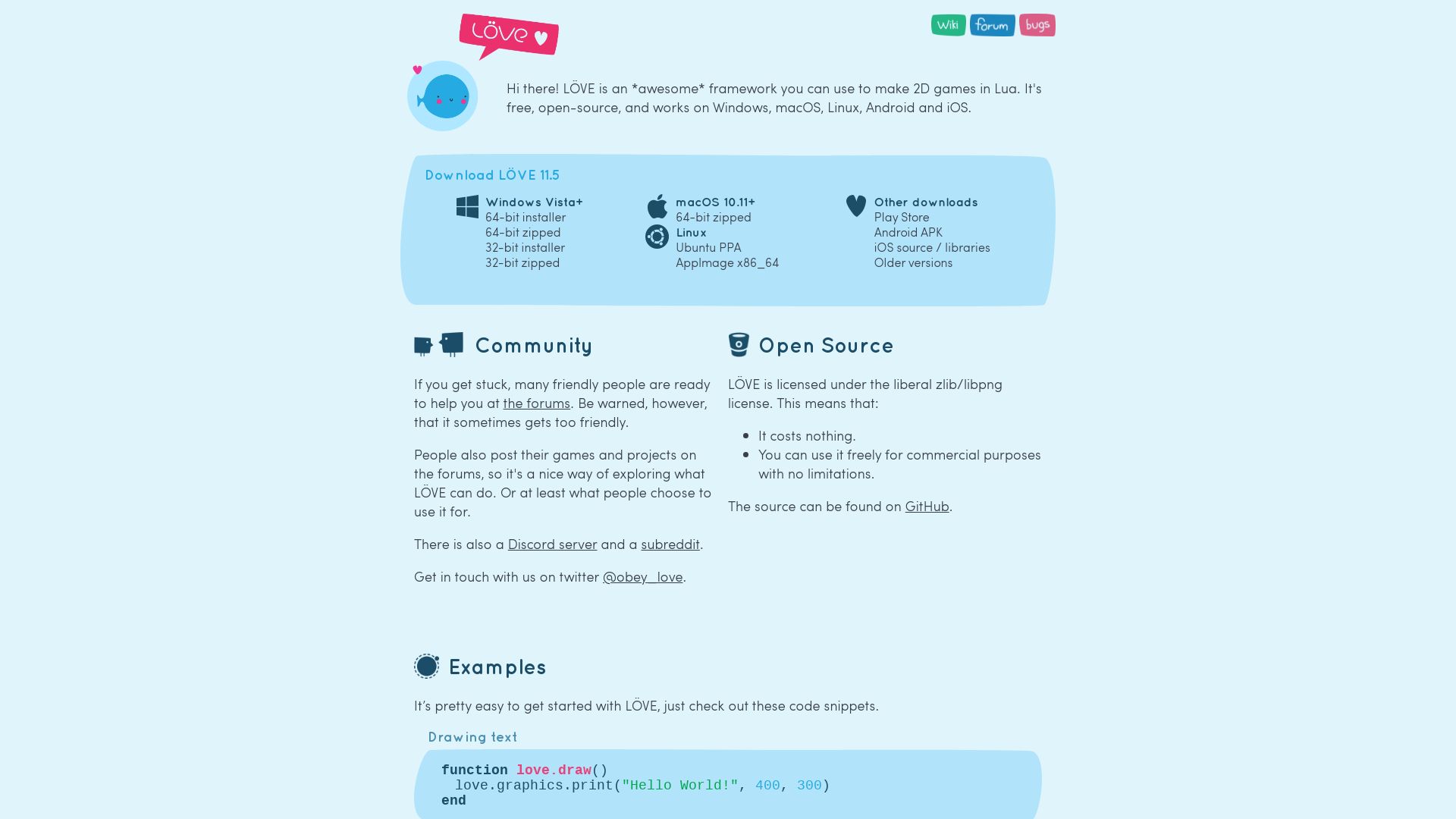
An efficient, open-source game framework, Love2D offers a brilliant canvas for 2D game development. This platform, established in 2008, uses the potent scripting language Lua and shines with an impressive range of features.
Love2D Top Features
- Compatibility: Love2D supports various platforms like Windows, Linux, macOS, iOS, Android, FreeBSD, OpenBSD, and NetBSD.
- Support for multiple formats: WAV, OGG, MP3, PNG, JPEG, GIF, TGA, and BMP formats are supported.
- Extensive Functions: Provides access to video, sound functions, OpenGL pixel shaders GLSL, touchscreens for mobile devices, joystick controls, and UTF-8.
- Additional Libraries: SDL, OpenGL, Box2D and LuaSocket library integration.
| Love2D’s 2D engine: | An exclusive engine for 2D game development. |
| Community Support: | Active assistance through Discord server, IRC and issue tracker. |
| pilöve: | A Raspberry Pi specific release of Love2D. |
Love2D Limitations
- Limited to 2D game development.
- Power and features fall short compared to Unreal, Unity.
- Lacks a graphical user interface.
- No guarantee of cross-platform games working between different Love2D versions.
- Limited number of modules.
Love2D Pricing
Love2D is published under the zlib License, making it a fully free, open-source framework.
Love2D Use Cases
Use case 1: Game Development Competitions
With efficient coding and extensive feature sets, Love2D is a top pick for game development competitions like Ludum Dare.
Use case 2: Indie Game Development
Independent developers have used Love2D to create noteworthy games like Move or Die, Mari0, and Kingdom Rush.
Use case 3: Cross-platform Games
With wide platform support, Love2D makes a practical choice for developers striving to create cross-platform 2D games.
Heaps

Delve into the powerhouse of gaming innovation, Heaps. A mature cross-platform graphics engine, Heaps is the foundation for high-performance games and has powered well recognized games like Rushberry Mercs, Voidrun, Nuclear Blaze, and Evoland, to name a few.
Heaps Top Features
- Cross-platform capability: Heaps, built with Haxe programming language, harmonizes with modern GPUs to deliver cutting-edge gaming experiences.
- Versatility: Exhibiting both 2D and 3D graphics capabilities, Heaps caters to a variety of game genres including Arcade, Role Playing, Real-time Strategy and Turn Based strategy.
- Performance: Recognized for its stability and performance optimization, Heaps echoes its strength in popular games like Dead Cells and Northgard.
| Feature | Benefit |
|---|---|
| Haxe Programming | Offers platform-independence, crucial for portability and future-proofing your game. |
| Community Association | Part of the thriving indie game development scene, affording access to extensive knowledge and help. |
| Library vs Engine | More of a library than a full-fledged game engine, providing more control and flexibility to skilled developers. |
Heaps Limitations
- While flexible, Heaps‘ library-like nature may prove challenging for beginners or those looking for a fully-featured engine right out of the box.
- Despite its strengths, it may not be the ideal transition tool for developers coming straight from Flash. Tools like HaxeFlixel are commonly recommended for such use cases.
Heaps Use Cases
Use Case 1 – High-Performance Games
When high performance and stability are critical, as in the case of demanding games like Dead Cells and Northgard, Heaps stands as a trusted solution.
Use Case 2 – Indie Game Development
With a robust community backing, Heaps allows indie game developers to share content, collaborate and combat common development challenges.
Use Case 3 – Platform Independent Game Development
For developers seeking platform independence, Heaps offers a stepping stone, harnessing the power of Haxe to deliver portable, adaptable results.
Fyrox
Presenting Fyrox, a cutting-edge 2D/3D game engine with a native editor akin to Godot, written in Rust. Boasting cross-compatibility with a multitude of platforms including Windows, Linux, macOS, Android and more, Fyrox was created with the future of game development in mind.
Fyrox Top Features
- Cross-platform compatibility: Windows, Linux, macOS, WebAssembly, and even Android.
- Advanced asset manager with async asset loading, permitting seamless workflow and efficient utilization of resources.
- Support for a multitude of formats: PNG, JPG, TGA, DDS for textures; FBX for model loading; WAV, OGG for sound.
- Unique features such as animation blending, root motion, blend space and audio enhancements like audio buses, audio bus graph.
- Community support via Discord, Patreon, Boosty along with a plethora of learning materials like the official Fyrox book and online tutorials.
| Feature | Description |
|---|---|
| Functionality for dynamic model instantiation | Allows dynamic model creations in real-time |
| Animation Techniques | Blend space for blending animations, blend shapes for dynamic 3D mesh changes, special animation techniques for root motion, and more. |
| Sound buffers for Sound Sources | Supports sound buffers in WAV and OGG formats |
Fyrox Limitations
- Learning curve may be steep owing to the wide array of features.
- Community support, while robust, may be slower than dedicated customer support.
Fyrox Use Cases
Use case 1: Game Development
With its dynamic model instantiation and variety of animation techniques, Fyrox offers a comprehensive suite for game developers.
Use Case 2: 3D Animation
Fyrox, with its inbuilt support for animation blending and root motion, becomes a powerful tool for creators in the 3D animation space.
Use Case 3: EdTech
In EdTech, Fyrox’s variety of modeling and texturing capabilities can enrich digital learning resources with interactive components.
Unity

Meet Unity – launched in 2005, a maestro game engine that breathes life into both 3D and 2D games. It’s an all-rounder, adaptable across diverse operating systems and captivates creators with its capabilities beyond gaming, including Augmented Reality and 3D simulations.
Unity Top Features
- Commanding ability to create cross-platform games for Android and iOS
- Built-in suite of tools, impressive rendering technology, and superior features to support high-standard game creation.
- Bountiful asset store teeming with a dynamic array of pre-designed textures and features for innovative game designs.
- Proffers a variety of coding languages including BOO script, Javascript, and C#.
- Harbors an engaged developer community promoting exchange of knowledge and feedback for continuous system improvement.
| Version | Benefits |
|---|---|
| Unity Free | Full features for novices and budget-conscious developers. |
| Unity Pro | More sophisticated features for professional development. |
Unity Downsides
- The upcoming pricing model can cut deep into the pockets of indie, solo, and mobile developers.
- Amplified concerns over possible abuse of per-install fees and a sudden price shift.
- Developers cite worries over the new Unity’s fee system, potentially derailing digital preservation efforts.
- Unity’s unannounced changes, especially concerning retroactive fees, have provoked trust issues amongst its users.
Unity Pricing
The archaic Unity Plus subscription tier is all but lost to history. The new pricing model rolls out on January 1, 2024. Games installed bear a fee, though the structure emphasizes on the ‘ability to pay’, with “standard” markets like the US and UK billed higher than “emerging” jurisdictions such as India and China. The sharp sting is buffered for the fresher crowd with a free version, and the install fee isn’t implemented until a game reaches $200,000 in revenue and overtakes 200,000 installations.
Unity Use Cases
Mobile Game Development
Unity shines bright in mobile game development, its compact yet powerful feature set allows developers to create immersive mobile games with brilliant visuals.
AR/VR Games
With Unity, the boundaries between reality and fantasy blur. Its advanced tech fosters creation of lifelike augmented reality (AR) and virtual reality (VR) games.
3D Simulation
Unity’s versatility extends to non-gaming arenas too. It enables developers to create sophisticated 3D simulations, making it a must-have for budding and seasoned developers alike.
Substance Designer
Substance Designer, a part of Adobe’s Substance 3D Package, is a material-authoring software used primarily for creating meshes and materials. It is an excellent tool for creating tiling textures and is renowned in the gaming industry for its capability to make textures compatible with any engine into which they’re imported.
Substance Designer Top|Best Features
- Spline and Path tools for generating, transforming and rendering 2D shapes.
- Updated Dot node with ‘portal’ functionality for data transfer without a wire connection.
- Support for loops repetition within Substance Function Graphs via Substance Engine 9.
- Quick access to tutorials, project settings with the added Home Screen.
- Surface patterns creation, pattern scattering control, and image warping control sections available.
| Feature | Description |
|---|---|
| Spline Tools | 25 new nodes for generating, merging, transforming, and rendering splines. |
| Path Tools | 10 nodes for generating paths from grayscale masks, converting to splines. |
Substance Designer Disadvantages
- The software has discontinued its procedural geometry toolset and model graphs have been removed entirely.
- System requirements may prohibit users with lower-spec devices from using Substance Designer.
Substance Designer Pricing
Substance Designer operates on a subscription model pricing it at $19.99/month or $219.88/year via Adobe’s Substance 3D subscriptions. A perpetual license can also be purchased for $149.99 through Steam. For Linux users, a Creative Cloud Plan for Teams, priced at $1,198.88/year, is essential. Note, a one-time purchase option is also available for non-subscription users.
Substance Designer Use Cases
Use case 1: AAA Game Development
The software’s top-notch mesh and material creation make it ideal for use in AAA game development. Its use can be seen in highly-acclaimed games such as Assassin’s Creed Valhalla and Deathloop.
Use case 2: Indie Game Development
Despite the rigorous requirements of indie game development, Substance Designer continues to be a reliable tool for developing engaging and complex graphics due to its easy manipulation of 2D shapes and loop repetition.
Use case 3: Visual Effects Studios
Substance Designer has proved to be a fundamental part of creating stunning visual effects. Its Spline and Path tools, along with its high quality mesh and material creation, ensure attractive, engaging visuals for the silver screen.
Stride
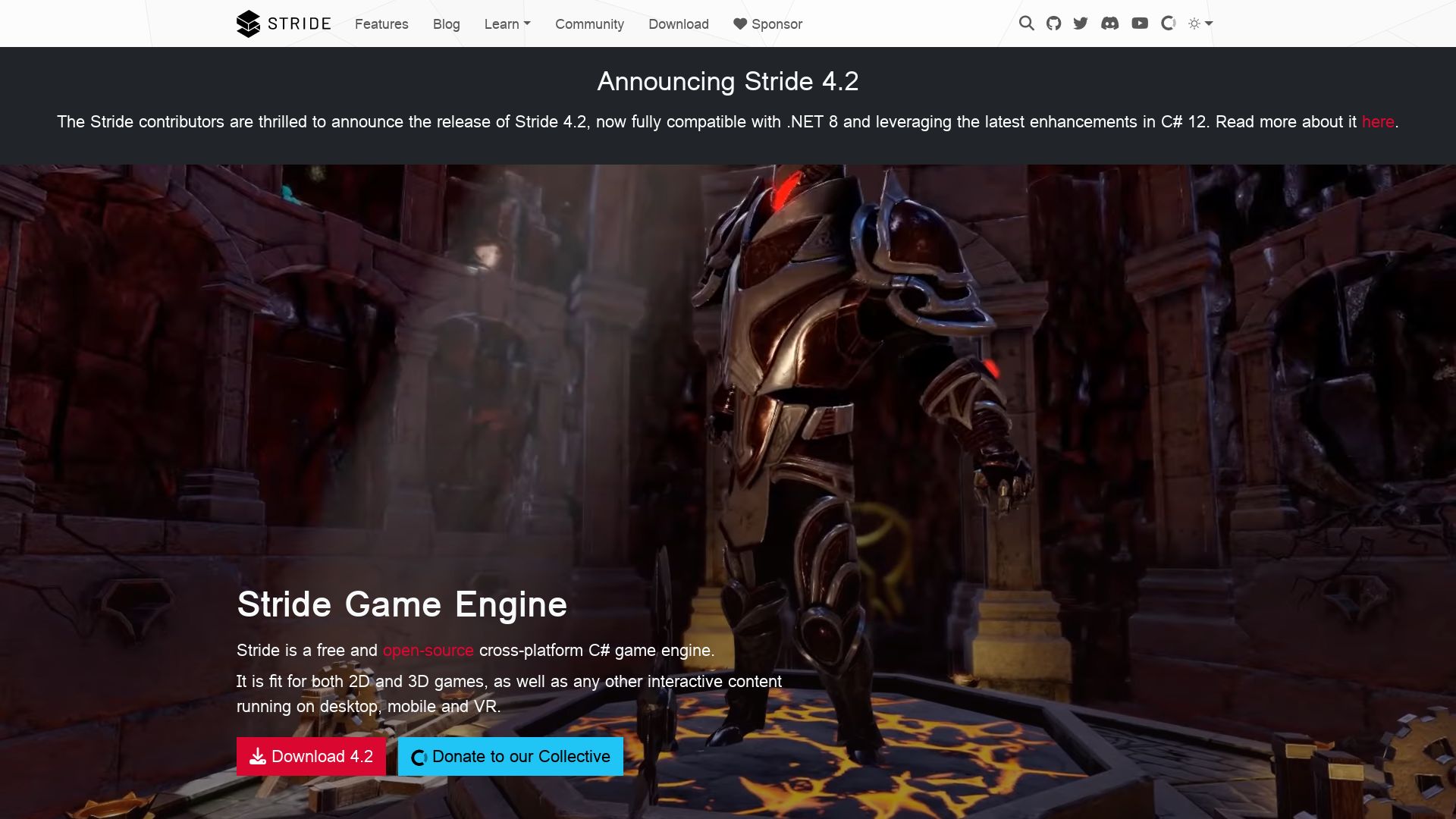
Stride, initially known as Xenko, is a free and open-source 2D and 3D cross-platform game engine. Originating from Silicon Studio, Stride facilitates PC, mobile, and VR game creation.
Stride Top Features
- C# suite tools – Tightly integrated with the .NET environment.
- Customizable shader system – Greater control on look and performance of graphics.
- Integrated environment (Game Studio) – Seamless import, creation, and arrangement of assets.
- PBR layered material editor – High fidelity rendering of materials.
- Full tool-chain support – Sprites, scripting, UI and more within the encapsulated ecosystem.
| Feature | Benefits |
|---|---|
| Physically-Based Rendering (PBR) | Provides high-quality visuals for game assets. |
| Platform Support | iOS, Android, Windows UWP, Linux, PlayStation 4, vvvv gamma |
| Entity component system | Ease of organizing and managing game elements. |
Stride Downsides
- Community-supported model: The engine is no longer backed by Silicon Studio, potentially affecting its long-term viability.
- Stride’s power and complexity may pose a higher learning curve for beginners.
Stride Pricing
Stride is free and open-source under the MIT License.
Stride Use Cases
Video Game Development
Stride’s extensive features and cross-platform support make it ideal for developing games for multiple platforms.
3D Rendering
Stride’s robust 3D rendering capabilities make it a valuable resource for high-quality 3D content creation.
VR Content Creation
Stride’s VR readiness makes it a top choice for virtual reality content developers.
Raylib
Developed by Ramon Santamaria and a team of passionate contributors, Raylib emerged on the global tech stage in 2013. Inspired by the Borland BGI graphics library and the XNA framework, it reflects a unique integration of digital trends and hardware capabilities.
Raylib Top Features
- Written in C (specifically C99) ensuring high performance and efficient memory usage.
- Boasts the cross-platform capability with support for multiple platforms including Windows, Linux, macOS, FreeBSD, Android, Raspberry Pi, and HTML5.
- Comprises a powerful Fonts module supporting SpriteFonts, BMfonts, TTF, SDF, broadening the horizon of graphical applications.
- A generous set of bindings for over 50 programming languages, embracing global coding diversity.
- Vibrant shaders support ranging from Model shaders to Postprocessing shaders for enriched visual effects.
- VR stereo rendering support enhancing the realism of 3D models and scenes.
| Feature | Description |
|---|---|
| Hardware Acceleration | Employs OpenGL for hardware acceleration, including a unique OpenGL abstraction layer called ‘rlgl’. |
| Audio Support | Comprehensive audio loading and playing with streaming support including formats like WAV, OGG, MP3, FLAC, XM, MOD. |
| Data Storage | Offers persistent data storage with two signature functions, increasing the flexibility and versatility of applications. |
Raylib Limitations
- Lacks certain advanced features considering its focus on prototyping, tooling, and education.
- Might require good familiarity with the C programming language to fully leverage its capabilities.
Raylib Pricing
As a torchbearer of digital inclusivity, Raylib is an open-source tool that is freely accessible to all curious minds around the globe.
Raylib Use Cases
Use case 1: Education
Raylib serves as a global ally in imparting programming knowledge, especially in 3D graphics and modelling, making it a popular tool in educational institutes worldwide.
Use case 2: Prototyping
Developers seeking a quick and efficient method to prototype their graphical applications often turn to Raylib for its simplicity and convenience.
Use case 3: Tooling
With strong cross-platform support and hardware acceleration, Raylib proves to be a solid choice for tooling in various embedded systems and graphical applications.
Panda3D

Born out of the creative minds of Disney Interactive and later developed with Carnegie Mellon University, Panda3D has rightly earned its fame as a powerful game engine developed for 3D rendering and game development. Originally designed for the magic of Disney’s VR adventures, this open-source engine sustains today’s impressive range of commercial games and university projects.
Panda3D Top Features
- Fully supported Python and C++ scripting garnishing maximum flexibility.
- Engine structures automatically managed with Python’s garbage collector, offering practicality.
- Advanced graphical features including custom shaders, per-pixel lighting techniques, gloss and normal map, and automatic shader synthesis.
- A range of additional capabilities: 3D audio, a physics system, collision detection, keyboard and mouse support, networking, and AI.
| License | Revised BSD license for versions after May 28, 2008. |
| Platforms | Microsoft Windows, Linux, macOS, Free BSD |
| Open Source Contributions | Welcomes bug reports on their GitHub and supports through OpenCollective campaign |
Panda3D Limitations
- Requires a basic knowledge of Python and APIs – not ideal for absolute beginners.
- Though it offers a cross-compile option for Android, it is not primarily mobile focused.
Panda3D Pricing
True to its roots in the open source community, Panda3D is completely free.
Panda3D Use Cases
Use case 1: Game Development
With features suited to create immersive 3D games and a robust engine, Panda3D has found its fame with commercial games like Toontown Online and Pirates of the Caribbean Online.
Use case 2: Academic Projects
Given that Panda3D is free, open-source and powerful, it supports the academic game development agendas at institutions such as the Carnegie Mellon’s Entertainment Technology Center.
Use case 3: VR Research
Its roots in Disney’s VR agenda make Panda3D a choice engine for Innovative VR research projects.
Sculptris
A vibrant digital playground where creativity thrives, Sculptris Pro redefines the boundaries of 3D graphic modeling. Affiliated with the renowned ZBrush, Sculptris liberates artists from the technical constraints of topology, allowing them to focus solely on the visual aspect.
Sculptris Top Features
- Unique Sculpting and Painting Brushes: The dynamic brushes of Sculptris reshape model topology on the fly, letting artists compel model fine-tuning, and detail alteration.
- Tessimation: Combining robust tessellation with real-time decimation, Sculptris Pro pioneers a unique method dubbed “Tessimation”, optimizing output quality.
- Density Control: The technological marvel of Sculptris allows for varying topology density relative to brush size, allowing large brushes for broader surface deformations and smaller ones for intricate detailing.
| Feature | Benefit |
|---|---|
| Dynamic Topology | Sculptris Pro mode grants the ability to grow parts of a model or erase details disregarding the underlying topology. |
| Compatibility | Sculptris seamlessly integrates with DynaMesh, ZSphere adaptive skins, imported models, and decimated models. |
| Mesh as Virtual Clay | Sculptris nimbly transforms mesh into virtual clay, offering a vibrant color range and leaving ample room for creative exploration. |
Sculptris Limitations
- Learning Curve: While the toolset is favored by beginners and intermediates, mastering it may require time.
- Hardware Dependency: With its technologically advanced features like density control and real-time decimation, Sculptris can be hardware-intensive.
Sculptris Pricing
Not stated in the provided company summary.
Sculptris Use Cases
Use Case 1: Gaming and Animations
Sculptris equips game developers and animators to create and refine character models with remarkable precision and flexibility.
Use Case 2: Industrial Design & 3D Printing
From iterating design concepts to modifying CAD files, Sculptris serves as a valuable tool for industrial designers and 3D printing specialists.
Use Case 3: Photorealistic Illustrations
Artists can harness the power of Sculptris to bring unparalleled photorealism to their illustrations, pushing the boundaries of imagination.
Juicer
An advanced solution for juicing, Juicer comes in two models: masticating and centrifugal, each with different strengths geared towards specific juicing needs. Used predominantly for extracting juice from fruits and vegetables, this cutting-edge device separates skin, pulp, and pips to leave you with pure, highly nutritious juice.
Juicer Top Features
- Nama J2 Cold Press: High yield, minimal prep work with three-tiered design, noise-free, compact.
- Omega H3000D Cold Press: Offers the best value, produces nutrient-rich juice, well-built, convenient storage.
- NutriBullet Juicer Pro: Fast, user-friendly model, designed to streamline your juicing practices for maximum health benefits.
| Feature | Description |
|---|---|
| Functional Design | Efficiently processes layered produce yielding tall, heavy, foam-free juice. |
| Health Boost | Forms part of a healthy regimen, enhancing the flavor of your juice and potentially contributing to an improved lifestyle. |
| Easy Cleanup and Store | Easy to disassemble for cleaning and compact for convenient storage. |
Juicer Limitations
- Machine Noise: Particularly with centrifugal model which operates at a quicker speed but is also louder.
- Size: Centrifugal model takes up more kitchen space due to its bulkier design.
Juicer Pricing
Investing in a Juicer depends on your frequency of juicing and choice of produce, alongside preferences for the type of juice and available kitchen space. It’s an investment into health and longevity.
Juicer Use Cases
Commited Health Enthusiasts
For individuals with a focus on maintaining and enhancing their health, Juicer’s nutrient-rich, high-yield output is essential in forming a long-term healthy diet regimen.
Veggie and Fruit Lovers
Juicer is ideal for people who want to experience the optimal flavor and nutrient content of fresh fruits and veggies. Its functionality allows for a variety of produce input, including soft fruits and leafy vegetables.
Professional Kitchen Setups
Professional chefs and kitchen setups can streamline their juice prep with Juicer’s easy use, quick juicing, and simple cleanup, making it a boon in time-constrained culinary environments.
Defold

A fortuitous gift to the worldwide fraternity of game developers, Defold emerges as an open-source, free-to-use game engine. Conceptualized by creative minds from Avalanche Studios and generously donated to the global community, it proffers a platform for dynamic and flexible game development for mobile, desktop, web, and console applications.
Defold Top Features
- Zero Licensing Fees: Defold arrives at no cost, requiring neither upfront investment nor royalties.
- Universally Accessible: Whether you use Linux, Windows, or macOS, Defold’s editor has you covered.
- Interactive gaming tools: A built-in code editor, debugger, UI editors, and scene streamlines the game building process.
- Lua Logic: Infuse your game logic with versatile Lua scripts, supplemented with native code if required.
- Community Focused: Known for its friendly community and extensively detailed technical documentation, learning Defold is simplified.
| Feature | Benefit |
|---|---|
| VSCod Option, CLI build system | Augments workflow efficiency |
| Active Discord community, forums | Continuous learning and troubleshooting assistance |
| Source code availability | Convenience of forking and customization |
Defold Limitations
- 3D Game Development: Defold’s main focus rests on 2D games. 3D game development is in progress and expected to conclude by the end of 2020.
- Small Development Team: The scale of game development might be limited due to a smaller team size.
Defold Pricing
Keeping with the ethos of open environments and community empowerment, Defold is absolutely free. It rejects all notions of upfront costs, licensing fees, or royalties, making it accessible to all potential game creators.
Defold Use Cases
Use case 1
For developers seeking a dependable open-source toolset to innovate and implement novel desktop game concepts, Defold’s propensity for customization and feature-rich framework make it an ideal choice.
Use case 2
Beginner-indie game creators looking to foster their game-play mechanics onto mobile platforms will find Defold’s cross-platform building capabilities and accessible Lua scripting an invaluable advantage.
Use case 3
For educational institutes aiming to nurture a culture of programming and game-development creativity among students, Defold’s zero cost, open-source nature, and supportive community offer the perfect breeding ground for budding technologists.
Hannah Stewart
Content writer @ Aircada, tech enthusiast, metaverse explorer, and coffee addict. Weaving stories in digital realms.




